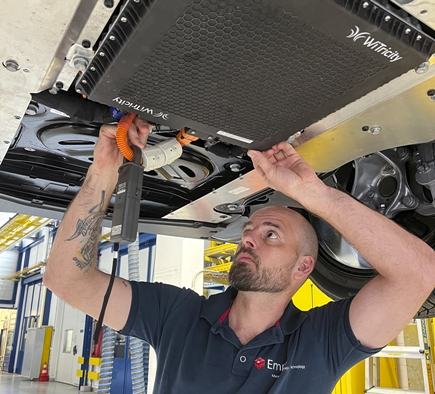Inductive charging of electric vehicles
Unplugged
What is already common practice for toothbrushes and cell phones will also be used for electric cars in the future: inductive charging without any cables. Together with partners, Empa is investigating the advantages and drawbacks of this technology in everyday life. One step has already been taken: The very first vehicle in Switzerland that has been converted for this purpose received road approval.

It couldn't be more convenient: If you maneuver your electric car correctly onto the designated parking space, the charging process starts automatically. A base plate in the parking lot transmits energy via a magnetic field to a receiver plate on the vehicle's underside and then to the battery. The technology for inductive charging of electric cars already exists and is being developed by the US company WiTricitiy, for example, which also has a subsidiary in Switzerland. What is missing is the regulatory framework – and practical experience of the advantages and disadvantages of inductive charging compared to wired, conductive charging. This is precisely where the INLADE project comes in: "We want to find out how inductive charging proves itself in everyday life and what regulatory changes will be necessary for the concept to become established," explains Mathias Huber from Empa's Chemical Energy Carriers and Vehicle Systems laboratory.
While the permissions for the charging stations are still pending, the first vehicle equipped with a charging plate has already received road approval. This required extensive electromagnetic compatibility (EMC) measurements and electrical safety tests. "The aim was to ensure that the magnetic field during inductive charging does not have any negative effects on other devices inside and outside the vehicle and, of course, on people," explains Huber. Together with representatives of project partner Eniwa AG, who operate this first vehicle, the Empa researcher accompanied the tests in the laboratory of the EMC Test Center in Regensdorf. Empa will soon be putting its own prototype vehicle and a corresponding charging station into operation. The aim is to be able to assess and evaluate the energy efficiency and reliability of the new system. "We are investigating the efficiency of both charging systems in different environmental conditions such as rain or snow," says Huber. According to the manufacturer, the efficiency of inductive charging should be around 91 percent. Huber: "These values are comparable with wired charging."
Simplify bidirectional charging

While Empa is responsible for the technical analysis, researchers at the Zurich University of Applied Sciences (ZHAW) are investigating the experiences of vehicle users. The project is also evaluating potential use cases such as e-car sharing, electric buses, cabs and autonomous vehicles. INLADE is being led by the energy provider Eniwa AG from Buchs. Other partners are the municipal utility alliance Swisspower, Energie Thun AG and BRUGG eConnect AG.
Energy suppliers in particular see a great potential of the new technology for bidirectional charging, in addition to increased convenience for e-car owners. This involves using the car battery as a storage unit that feeds part of the energy back into the grid when it is not needed for driving. Vehicle batteries could therefore play a major role in stabilizing the electricity grid in the future – but only if they are connected to the grid. "When the batteries are virtually full, vehicles are generally not connected to the charging station, although in this state they would be predestined to temporarily make some of their energy available to the grid," explains Samuel Pfaffen, Head of Corporate Development at Eniwa. With inductive charging, there is no need to connect the vehicles manually via a cable, which makes it much easier to access the vehicles' battery.
The INLADE project was launched at the end of November 2023 and will run for two years. It is supported by the Swiss Federal Office of Energy (SFOE) and the cantons of Zurich and Aargau.
Mathias Huber
Chemical-Energy-Carriers-and-Vehicle-Systems
Phone: +41 58 765 4648
Stephan Kälin
Communications
Phone +41 58 765 4993
redaktion@empa.ch
Open Lab Day
On September 14, 2024, Empa Dübendorf will open the doors of its laboratories to the public. At over 70 stations, visitors will be able to experience current Empa research live on topics such as climate change, the energy transition, human and environmental health and much more. The stories in this issue give a small taste of the variety of materials and technologies that are discovered, researched, and developed in Empa's laboratories. Hungry for more? Visit us on September 14!
Read the latest EmpaQuarterly online or download the PDF version.
-
Share







